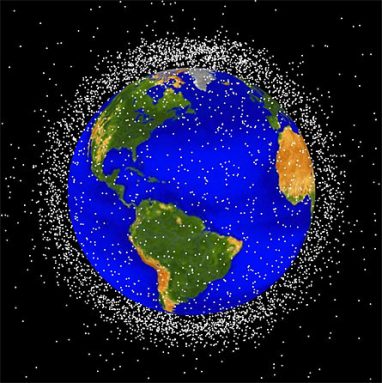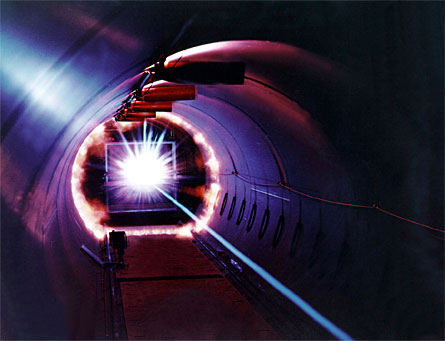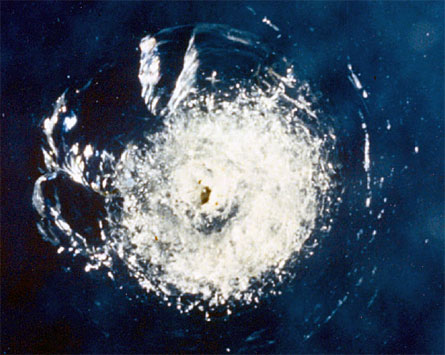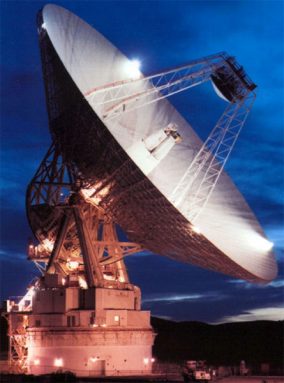The solar system’s biggest junkyard
The science of tracking millions of pieces of garbage that orbit Earth is tricky and essential.
 |
|
Each white dot represents an individual piece of tracked orbital debris. This image shows the Low Earth Orbit, which is the region from the Earth’s surface to 1,240 miles and contains the most space junk.
|
| NASA Johnson Space Center |
On a clear night, you can look in the sky and see the moon and stars. You might even see the blinking light of a working satellite as it flies past, on its way around the Earth.
And, even though you cannot see it, you are also looking at the largest junkyard in the solar system.
Higher than the highest clouds but much closer than the moon, the bulk of the junkyard stretches from the Earth’s surface to 20,000 miles overhead. There are tens of millions of pieces of rubbish there. Some of the pieces are rocks and dust from passing comets, but most of them are manmade and called “orbital debris” (pronounced duh-BREE).
There are some unusual things up there, like a camera that floated away from astronaut Sunita “Suni” Williams in December 2006. Other astronauts have lost tools like wrenches and screwdrivers. In 1965 astronaut Ed White even lost a spare glove. Most of the junk, however, comes from large satellites and rockets that fell apart after they stopped working.
Together, all the space junk would weigh about 11 million pounds on Earth, or more than 3,000 cars. The largest piece is a part of a rocket about the size of a minivan. The smallest piece would fit on your pinkie fingernail with room to spare.
“It’s like a classic environmental problem, like water pollution or air pollution,” says Nicholas Johnson. Johnson is the Chief Scientist for Orbital Debris at the NASA Johnson Space Center in Houston. His job is to keep track of the orbiting garbage.
The junkyard is a serious problem for the future of spaceflight.
“You’ve got multimillion satellites in orbit all the time, and manned space flights,” says Joe Gambrell, who helps keep track of both working and broken-down satellites. His main tool is the U.S. Space Surveillance Network, which is part of the U.S. military. Gambrell works at the Peterson Air Force Base in Colorado Springs, Colo. “If you don’t track debris, you risk some kind of collision,” he adds.
In 2007, the space junkyard grew by more than 100,000 pieces. That’s more than any other year since people started launching satellites into space. The problem of space junk is not going away, and scientists are watching closely.
Danger in Orbit
A “satellite” is any object that orbits another object, held close by gravity. The moon is a satellite of the Earth, and the Earth is a satellite of the sun. These are natural satellites. Manmade satellites, which are built on Earth and launched into space, are used for communications, scientific studies and military applications.
In the last 50 years, human beings have launched thousands of artificial satellites into space. When a satellite stops working, it usually falls back toward the Earth and burns up in the atmosphere. Satellites at high altitudes, however, sometimes remain in Earth’s orbit.
Later, they may fall apart or explode into thousands of smaller pieces. The higher the satellite, the longer it stays in orbit, and the more likely it is to break apart. The pieces may stay in orbit for years, decades or even centuries.
 |
|
At the NASA Ames Research Center, scientists simulate what would happen were a tiny piece of space junk to hit a spacecraft.
|
| NASA |
Space junk races around the Earth at breakneck speeds. Most pieces fly through space at more than 20 times the speed that sound travels on Earth. Going that fast, even the smallest pieces mean big trouble for spacecraft. For example, a tiny marble in orbit around the Earth can have as much energy as a bowling ball going 500 miles per hour, or a car going 30 miles per hour.
 |
|
A tiny fleck of paint struck and cracked one window of the space shuttle Challenger while it was in space in 1983. The shuttle returned to Earth safely from that mission.
|
| NASA Johnson Space Center |
In 1983, a small gouge appeared in one window of the space shuttle Challenger while it was in space. When the shuttle returned to Earth and scientists analyzed the window, they found that the crack was caused by a tiny, orbiting fleck of paint. If the shuttle had been struck by a larger piece of junk, the astronauts may have been in danger.
Many other satellites and space shuttles have also shown damage from tiny pieces of trash. When the space shuttle Endeavour returned to Earth last August, its radiator panels had small holes from space garbage. Last year, two satellites had to be redirected to avoid collisions with big pieces of junk.
The U.S. Space Surveillance Network and NASA work together to keep track of the largest pieces. When the shuttle is in orbit, for example, their attention is on nearby junk that may get in the way. If there is even a small chance of a collision, then the shuttle changes direction.
Watching the garbage
About 17,000 pieces of garbage are larger than 4 inches, which is slightly smaller than a softball. The Space Surveillance Network keeps a list of all these pieces, using dozens of telescopes and antennas on Earth and in space to watch them. Because all the pieces are in motion all the time, keeping track is difficult (but not impossible).
Monitoring the space junk is a problem of energy and motion. To keep track of the junk, the scientists have to know two things: where the garbage is now, and where it is going to be in the future.
 |
|
This antenna, located in the Mojave Desert, California, can use radio to detect tiny pieces of junk, if they’re not too high.
|
| NASA Johnson Space Center |
To find out where a piece is now, scientists use telescopes and high-powered antennas to watch it fly through space. Every day, scientists must make sure each piece is where they expect to find it. A “lost piece” could mean serious danger for a working satellite or space shuttle.
To find out where the piece is going, scientists measure its speed and direction as it crosses the sky. Some of the pieces move in an almost perfect circle around the Earth. Other pieces move in elliptical orbits, which means they are sometimes closer to Earth and sometimes farther as they fly. The measurement of direction is complicated because junk can move north or south, east or west, and up or down.
By knowing the location, speed and direction of each big piece of junk, the scientists can predict where all the pieces will go. (Similarly, in baseball, an outfielder has to predict where a pop fly will land, if she wants to catch it. In soccer, a goalie has to predict where a ball will go, so he can block it.)
“We’re always looking about four days into the future, tracking objects which might come close,” says Johnson.
There are tens of millions of pieces smaller than softballs. Because there are so many small pieces, “We can’t [keep track] of them all,” Johnson says. Instead of watching each piece individually, scientists use telescopes and antennas to watch one patch of sky and count the number of pieces that pass overhead. With that small measurement, they can use a computer program to get a good idea of what the whole sky looks like.
Keeping track of all the junk is necessary to ensure that astronauts and working satellites can be safe. Like other environmental problems, space junk will get worse without careful monitoring and attention. In the future, pieces of junk will probably hit each other, making even more trash.
The more garbage that remains in orbit, the greater the risk to space flights. What can be done about the problem of space junk? The large pieces of junk cannot be brought back to Earth, Johnson says, because the technology is too expensive. Instead, he says, we should try to stop adding new garbage. For example, engineers are changing the way they build spacecraft.
“How you build your satellite can minimize debris,” Gambrell says.
A solution will require international cooperation. Last year, the United Nations General Assembly approved guidelines for how to reduce the risk of space junk. Johnson says that spacefaring countries came together because “the environment was getting worse every year.”
If countries work together to control the amount of trash we send into space, Johnson says, we can keep the problem under control. In the future, perhaps we can even clean up the mess.
“In time, either technology or economics will allow us to go out and [improve] the environment,” he says.







